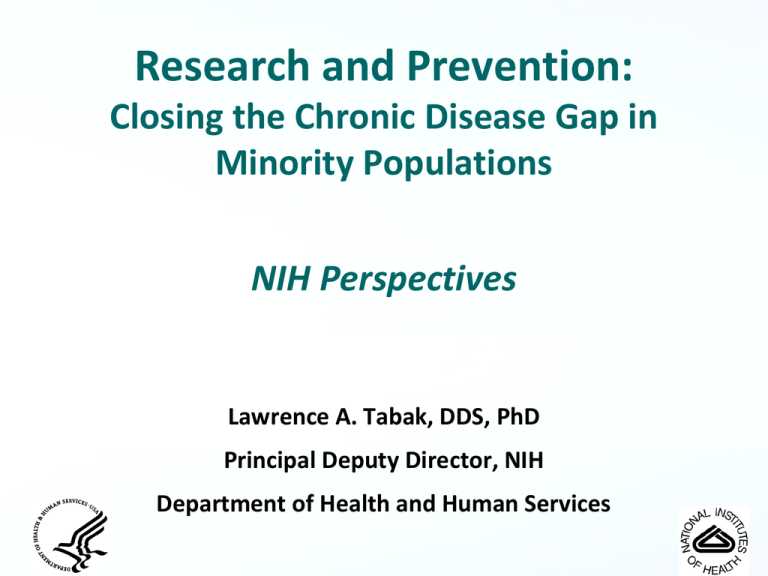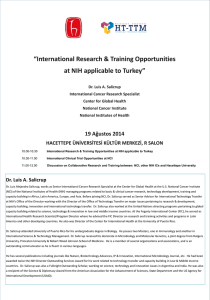NIH Perspectives
advertisement

Research and Prevention: Closing the Chronic Disease Gap in Minority Populations NIH Perspectives Lawrence A. Tabak, DDS, PhD Principal Deputy Director, NIH Department of Health and Human Services Closing the Gap: The View from NIH Health Disparities Research Minority Populations in Clinical Research Diversity of the Biomedical Workforce Closing the Gap: The View from NIH Health Disparities Research Minority Populations in Clinical Research Diversity of the Biomedical Workforce Health Disparities Research: The Plans HHS Health Disparities Action Plan NIH Health Disparities Strategic Plan and Budget HHS Disparities Action Plan Goals, 2010–2015 Transform health care Strengthen the nation’s Health and Human Services infrastructure and workforce Advance the health, safety, and well-being of the American people Advance scientific knowledge and innovation Increase the efficiency, transparency, and accountability of HHS programs NIH Health Disparities Strategic Plan Establishes principles for NIH’s health disparities agenda Outlines projects to address minority health and health disparities within each NIH Institute and Center, NIH Office of the Director Sets three major goals for each NIH IC: 1. Conduct and support intensive research on factors underlying health disparities 2. Engage in aggressive, proactive, community outreach, information dissemination, and public health education 3. Expand and enhance research capacity to create a culturally sensitive and culturally competent workforce NIH’s Health Disparities Research: Objectives Advance understanding of the development and progression of diseases and disabilities that contribute to health disparities among racial and ethnic minority, low-income, rural, and medically underserved populations Develop new or improved approaches for detecting, diagnosing, preventing, delaying, or treating the onset or progression of diseases and disabilities that contribute to health disparities Advance understanding of the causes of health disparities, e.g., non-biological bases of disease incidence and progression Research on Factors Underlying Health Disparities Areas of Emphasis Clinical and Translational Research Comparative Effectiveness Research Social Determinants of Health Health Services Research Innovative Health Technologies Genetics and Biological Factors Behavioral and Social Sciences NIH Research on Prematurity and Health Disparities U.S. rate of preterm births is >12%, far higher than many other developed nations In 2009, 13.9% of Black infants were low birthweight, compared to 7.2% of White infants NIH’s Maternal Fetal Medicine Units Network 14 clinical research centers Research includes identifying factors associated with disparities in quality of obstetric care/outcomes Significant findings to date: Weekly progesterone injections for women with previous preterm delivery reduces risk of preterm birth Magnesium sulfate before preterm birth provides neuroprotection Racial Disparities in Cardiovascular Disease (CVD) Morehouse and Emory Team up to Eliminate Health Disparities (META-Health) study African Americans experience a higher burden of CVD, while classification schema may underestimate CVD risk Study Findings: African Americans have higher levels of oxidative stress than whites (even after adjustment for differences in risk factors) Racial differences in oxidative stress may play a key role in racial disparities in CVD Metab Syndr Relat Disord. 2012 Mar 2. [Epub ahead of print] Colorectal Cancer Disparities Observation: Black men and women have higher incidence and mortality rates compared to white men and women Study Design: Screening sigmoidoscopy offered to study participants Subjects with polyps or lesions were referred to personal physician for follow-up colonoscopy (cost not covered by the study) Laiyemo et al, “Race and Colorectal Cancer Disparities: Health-Care Utilization vs Different Cancer Susceptibilities” JNCI 2010 Colorectal Cancer Disparities: Study Points to Healthcare Utilization Rates Study Findings: Blacks and whites equally likely to need follow-up colonoscopy after a screening sigmoidoscopy Blacks less likely to receive the follow-up colonoscopy No statistically significant difference in the risk of colorectal cancer by race based on colonoscopy results Closing the Gap: The View from NIH Health Disparities Research Minority Populations in Clinical Research Diversity of the Biomedical Workforce Conclusions: We found very small differences in the willingness of minorities, most of whom were African-Americans and Hispanics in the US, to participate in health research compared to nonHispanic whites. These findings, based on the research enrollment decisions of over 70,000 individuals, the vast majority from the US, suggest that racial and ethnic minorities in the US are as willing as non-Hispanic whites to participate in health research. Hence, efforts to increase minority participation in health research should focus on ensuring access to health research for all groups, rather than changing minority attitudes. PLoS Med 3(2): e19. doi:10.1371/journal.pmed.0030019, 2005 Minority Enrollment in NIH Domestic Clinical Research Closing the Gap: The View from NIH Health Disparities Research Minority Populations in Clinical Research Diversity of the Biomedical Workforce Diversity of the NIH-Funded Research Workforce Hispanic or Latino (of any race) White American Indian and Alaska Native Native Hawaiian and other Pacific Islander Other, unknown, not reported and more than one race Asian Black or African American 2010 US Census Bureau Report 2010 NIH Principal Investigators on RPGs Sources: US Census Report 2010; IMPACII; AAMC Greater Diversity in Research Workforce African Americans, Hispanics, and Native Americans: Represent 31% of U.S. college age population but only account for 14% of undergraduates in life sciences And even fewer in later stages Greater Diversity in Research Workforce: NIH Needs to Do More Greater Diversity in Research Workforce NIH’s Plan for Action: Evaluate current training programs Phase out unsuccessful programs, expand successful ones Increase number of early career reviewers, including those from underrepresented populations Examine grant review process for bias and develop interventions Improve support for grant applicants Gather expert advice on additional action steps ACD Working Group on Diversity in the Biomedical Research Workforce Reed Tuckson, M.D., co-chair UnitedHealth Group John Ruffin, Ph.D., co-chair NIH Lawrence Tabak, D.D.S., Ph.D., co-chair NIH Ann Bonham, Ph.D. AAMC Jordan Cohen, M.D. AAMC José Florez, M.D., Ph.D. Harvard Medical School Gary Gibbons, M.D. Morehouse School of Medicine Renee Jenkins, M.D. Howard University Tuajuanda Jordan, Ph.D. Lewis and Clark College Wayne Riley, M.D., M.P.H., M.B.A. Meharry Medical College Samuel Silverstein, M.D. Columbia University Medical Center Dana Yasu Takagi, Ph.D. University of California, Santa Cruz Maria Teresa Velez, Ph.D. University of Arizona M. Roy Wilson, M.D., M.S. NIH Keith Yamamoto, Ph.D. University of California, San Francisco Clyde Yancy, M.D. Northwestern University Lawrence.Tabak@nih.gov NIH Turning Discovery into Health








